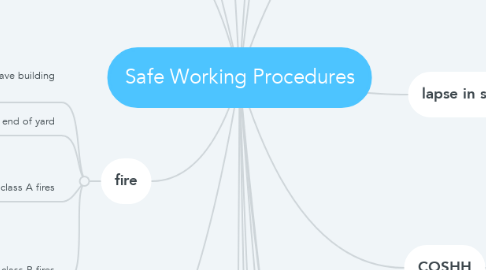
1. RIDDOR
1.1. reporting of injuries, diseases and dangerous occurrences regulations
1.2. employers report if any occur
1.2.1. e.g. fracture,amputation or asthma
2. security at your workplace
2.1. locks on tack room and kitchen door
2.2. padlock on haybarn
2.3. alarm system on haybarn and main barn
2.4. code lock on main gates
2.5. CCTV
3. personal data
3.1. kept secure to prevent fraud
3.2. to keep you safe
3.3. GDPR
3.4. medical details
3.4.1. incase of emergency to inform ambulance staff
3.4.2. so can put measures in place e.g. diabetic would need set meal times
4. fire
4.1. shout fire, let horses out and leave building and meet at evacuation point
4.2. hosepipe at each end of yard
4.3. class A fires
4.3.1. water extinguisher (RED)
4.3.2. foam extinguisher (CREAM)
4.3.3. dry powder extinguisher (BLUE)
4.4. class B fires
4.4.1. foam extinguisher (CREAM)
4.4.2. dry powder extinguisher (BLUE)
5. children at greater risk
5.1. closer to horse's hooves
5.2. don't listen as well as adults
5.3. excitable
5.4. less aware of danger
5.5. should always be supervised
5.6. wear PPE if necessary
5.7. give clear rules
6. manual handling
6.1. haynets
6.1.1. in wheelbarrow
6.1.2. close to body
6.1.3. handle from string and put over each shoulder
6.1.4. carry in front of you
6.2. water buckets
6.2.1. carry one in each hand - equal
6.2.2. ask for assistance
6.3. bale of shavings
6.3.1. in wheelbarrow
6.3.2. bent knees and straight back
6.3.3. stored under cover in dry area
6.4. shavings fork
6.4.1. prongs facing down
6.4.2. in wheelbarrow
6.4.3. in one hand
6.4.4. stored neat and tidy
6.5. feed
6.5.1. stored in seperate bins and off floor
6.5.2. dry area
7. HASAWA - everyone responsible for h+s in workplace
7.1. not exposed to unnecessary risks
7.2. employer should provide training and PPE
7.3. conduct risk assessment
7.4. employees should follow procedures and risk assessments
8. COSHH
8.1. control of substances hazardous to health
8.2. prevent exposure to them
8.3. training on how to use hazardous substances
8.3.1. tack cleaner, steroid creams, disinfectant
8.4. use gloves
9. lapse in security
9.1. lead to loose horses
9.2. compromise safety
10. why should accidents be reported and where
10.1. to prevent further accidents
10.2. keep a record for insurance
10.3. identify unsafe practice
10.4. recorded in accident book
11. waste in workplace
11.1. bottles, cans, plastic is recycled
11.2. droppings on muck heap
11.3. hay and haylage on muck heap
11.4. feed buried in muck heap to prevent vermin
11.5. feed bags general waste
11.6. haylage wrap (plastic) general waste
11.7. water down drain
11.8. muck heap moved into field and spread once full
12. environmental damage
12.1. damage caused to environment
12.2. caused by not recycling and burning materials not supposed to be burnt e.g. plastic
12.3. minimise by recycling and buying in bulk
12.4. switching off things when not in use
13. hygiene
13.1. wash hands regularly
13.2. wear gloves when putting on creams
13.3. putting things away
13.4. keeping things neat and tidy
14. accidents
14.1. make sure area is safe
14.1.1. remove horse
14.2. call ambulance
14.3. file it in accident book
15. PPE
15.1. hats
15.1.1. replaced after falls or to meet new standards
15.2. gloves
15.2.1. washed regularly
